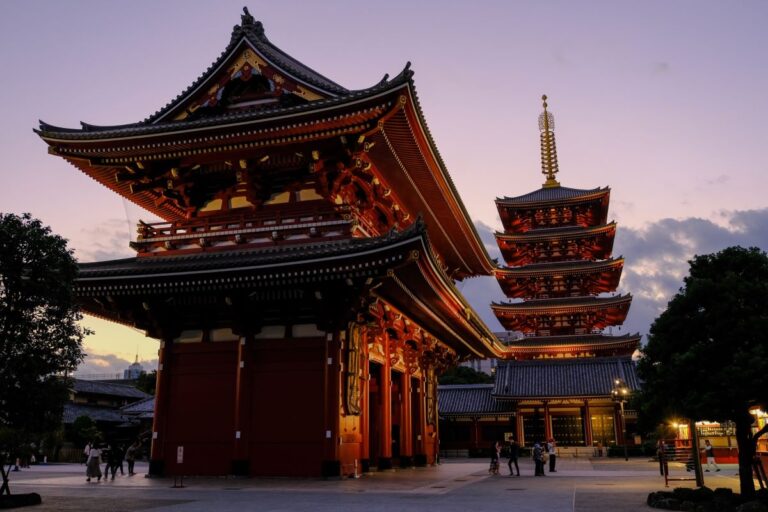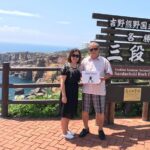Japan is a perfect place to finding something that’s unique. More than in most places, the Japanese continue to excel at a wide range of traditional arts and crafts, with regional gift specialties, called meibutsu, renowned for their quality workmanship and aesthetic appeal. In the more than twenty years I’ve lived in Japan, I’ve seen much of the country and found each region, from Hokkaido in the north to Kyushu in the south, offering distinctive, high-quality arts and crafts.
Gift-giving is something of an art in Japan, where a gift, omiyage in Japanese, successfully given honors the recipient, starting with the quality of the presentation. Gifts are traditionally carried in beautiful printed squares of fabric called furoshiki. Presented as a scarf, for which they double nicely, they make a uniquely Japanese fashion statement back home. I find that great gifts often come from looking at things with an imaginative eye. As with the high-tech goods for which Japan has become renowned, quality and attention to detail are hallmarks of a well-chosen omiyage.
In Tokyo’s trendy Harajuku district, where all the big names of fashion vie for attention, you’ll also find shops with lacquerware and exquisitely colorful wood block prints, both antique and contemporary, ceramics and yukata, the cotton house robe that is an omiyage favorite for visitors who want to add an exotic touch to someone’s wardrobe.
Most visitors come to Japan expecting everything to be very expensive. Surprisingly, although prices can be quite high for specific pieces, most traditional crafts also come at very affordable prices. For quick pricing, think of yen as cents, 100 yen to the dollar. Thus the ubiquitous 1000-yen note is equivalent to a $10 bill, the 10,000-yen note, our $100. Just position the decimal two in from the right and you’ve got approximate pricing in dollars and cents, although a more precise cost depends on the current rate of exchange. Thus 7950 yen becomes $79.50.
Suddenly that original wood block print of Mt. Fuji doesn’t seem so expensive. And the set of six delicately painted teacups, priced at 1500 yen, make a fabulous gift for only $15.00. Same for the embroidered purses at $5-$8 and the hand-painted sake set (for serving rice wine) at under $30. But the best buys were the exquisitely printed works of art, both contemporary and archival, that are to be found. Matted and framed they provide appealing wall art, exotic in theme and exquisite in color and detail. Contemporary pieces, some copies of traditional classics, others original artwork, are beautifully printed, providing omiyage of artistic merit for under $10.
Fine art prints (ukiyoe) are also readily available in Tokyo at surprisingly affordable prices. That means beautifully colored, finely registered works dating back to the 1820s, works by recognized masters, starting at $70, with many choices under $125. I bought my first ukiyoe print at a gallery in New York in the mid-1970s, when I was in my late 20s. I’d been attracted to the art form by my love of their exotic themes, intensity of expression, and richness of color. Remarkably, I found prices at about the same levels as I’d paid in the ’70s. To me, that had bargain written all over it.
Hand-carved netsuke, miniature sculptures of carved ivory used to secure the sash that is part of traditional men’s garb, offer another affordable traditional art form, with prices that start under $100, although the best collectibles go for many times that. In the detailed, miniature world of the netsuke, the Japanese have again achieved creative distinction.
Tokyo, Japan’s bustling capital, is also one of the world’s great shopping cities. Unlike New York or London, where much is centralized in a specific downtown, Tokyo includes a cluster of “downtowns,” Ginza and Harajuku, Shinjuku, Akasaka and Jimbocho to name a few, each a shopper’s haven.
Distinct in ambience and scale, they all draw crowds. With shopping a passion in modern Japan, the city has attracted retailers from around the world to Tokyo. Anyone with a name in fashion in Europe or America is well represented, as are a new generation of Japanese designers with international reputations. Fashion trends take hold here, with designer-label goods spotlighted in shops throughout the city, including designer-owned flagship superstores. The sticker-shock pricing doesn’t deter Japanese buyers who, in this and many other lifestyle choices, are willing to pay a premium for what’s stylishly hip and top-of-the-line.
For the visitor with a more modest budget, the best buys come with traditional arts and crafts at which the Japanese still excel. Textiles, for example, provide a variety of lightweight, easy-to-pack omiyage, including yukata (house robes), handbags, scarves, and contemporary clothing crafted of richly embroidered fabric from old kimono. For those with a large wall at home awaiting a stunning centerpiece, gorgeous antique kimono are another remarkable bargain at under $100 for kimono that originally sold for ten ties that. Even if you don’t buy, this is an art form it’s easy to admire for its rich colors and elaborate weaves.
Easier to consider are mid-thigh hapi coats and mid-leg kukata, or house robes. Generally made of lightweight cotton, yukata and hapi coats come in a wide variety of colors and prints, with hapi coats starting under $50 and yukata at $60-$125. Yukata can be found everywhere from second-hand shops to Ginza’s glitzy department stores, where the topmost floor is often dedicated to traditional arts and crafts that make possible one-stop shopping for those with limited time.
Lacquer ware provides another distinctive range of lightweight, well-priced omiyage. Older pieces of good quality can be found for $60-$100. There is also a well-priced contemporary alternative, though the lacquer here is applied on plastic, not the wood based frame of older pieces. Using real gold leaf, however, provides the deep rich finish that give it the look of a piece several times the $15-$50 you’ll spend.
Ceramic ware presents another selection of omiyage treasures. Carefully packed (many shops will provide this service), they can be safely carried as hand luggage, which limits the chance of breakage. I usually allow myself one art piece as hand luggage, packing it carefully with bubble wrap.
If buying gifts is part of the itinerary, pack light and carry an extra soft-sided suitcase in your check-in luggage. When you pack to depart, use your wardrobe to cushion breakables. I’ve rarely lost a piece to breakage in shipping if I was careful in the way it was packed.
Many shops can also arrange for shipping should you find an irresistible bargain…a four-panel, 6-foot high, hand-carved screen, for example, at a want to-get-it $129. Or a large, artfully carved and painted mask, priced at under $200, or the wooden sake barrels-cum-planters at $89. Even with packing and shipping tripling the cost, there are unique pieces worth considering.
The Japanese retain an affinity for the handmade papers of old. In Tokyo and other Japanese cities, paper goods specialty shops cater to a mix of Japanese and foreign clientele with everything from note cards to stationary bought by the page, or paper bound into handmade diaries or used in an infinite variety of fans. Elegant, distinctive and useful, fans run $6-$25, depending on variables like size, intricacy, quality of the paper, and whether it was hand-painted or printed by machine.
Surprisingly, in a high-technology world in which Japan excels, it is the traditional arts, often handmade, that offer the best bargains. While you may find the latest model digital camera in a camera shop in Akihabara, the Tokyo shopping district where high-tech electronics reign, prices run high. Cutting-edge technology, eve on Japanese-made goods, costs less in the U.S.
Food represents another whole category of omiyage possibilities. Anywhere you go in Japan, gift shops feature a wide selection of foods packaged for travelers, including specialties of the region. There are a wide variety of crackers, candies, fruits and light confections, all beautifully packaged in the tradition of omiyage. On this last trip I bought small banana-filled cakes and azuki bean sweets, hot wasabe, and food spices as self-directed omiyage, bought with pocket change at a shop at the airport. I like to bring such things home. They are prods to memory, providing future meals with the exotic taste of some past adventure. In a world where cookbooks are best sellers, there are likely some distinctive culinary experiences to be gifted to the gourmet chefs on your omiyage list.
In all your gifting, shop with an eye to detail that emphasizes creative skill: fine-line details on a painted face, for example, or feet and hands done well in a ceramic or bronze sculpture. This is a hallmark of craftsmanship and talent in both older and contemporary pieces, whether handmade or made by machine. Remember to keep receipts accessible. If a value-added tax credit applies they will be necessary. Leave time for collecting your VAT rebate at the airport at your time of departure.
One last bit of omiyage advice. If you see something perfect, don’t hesitate. Things that are perfect benefit from spontaneity. So pack that second bag and get ready to celebrate your great time in Japan with omiyage for those at home.




